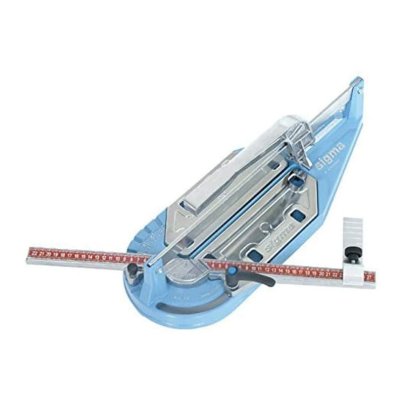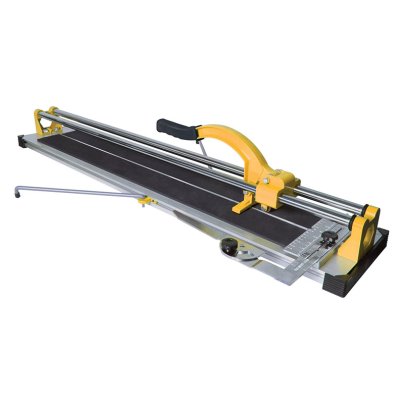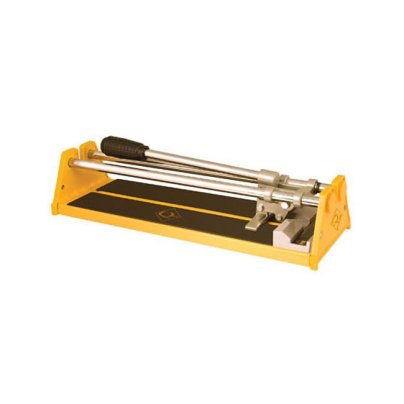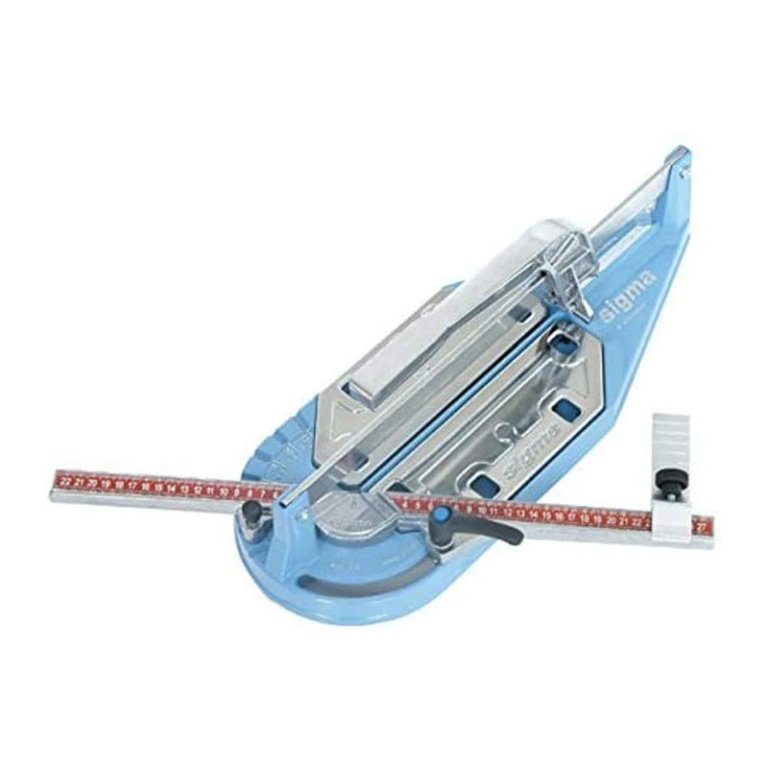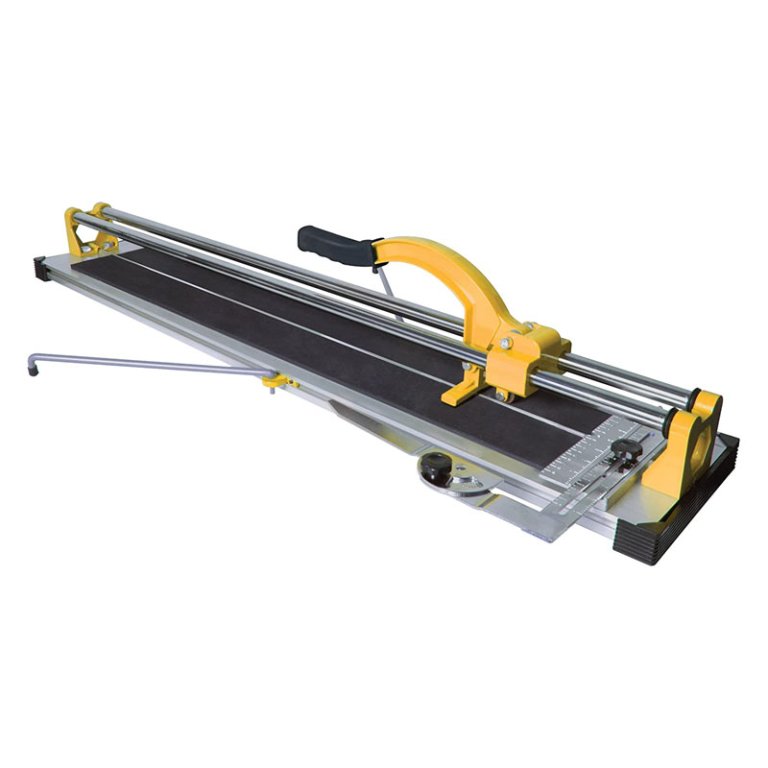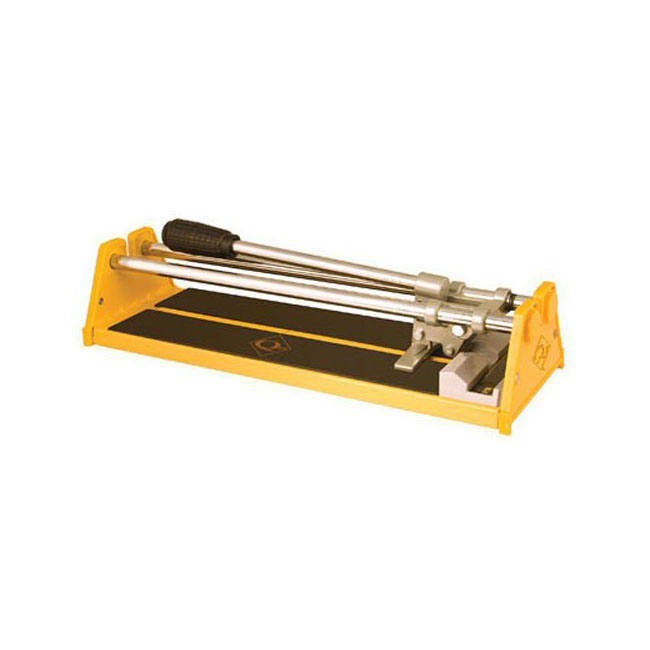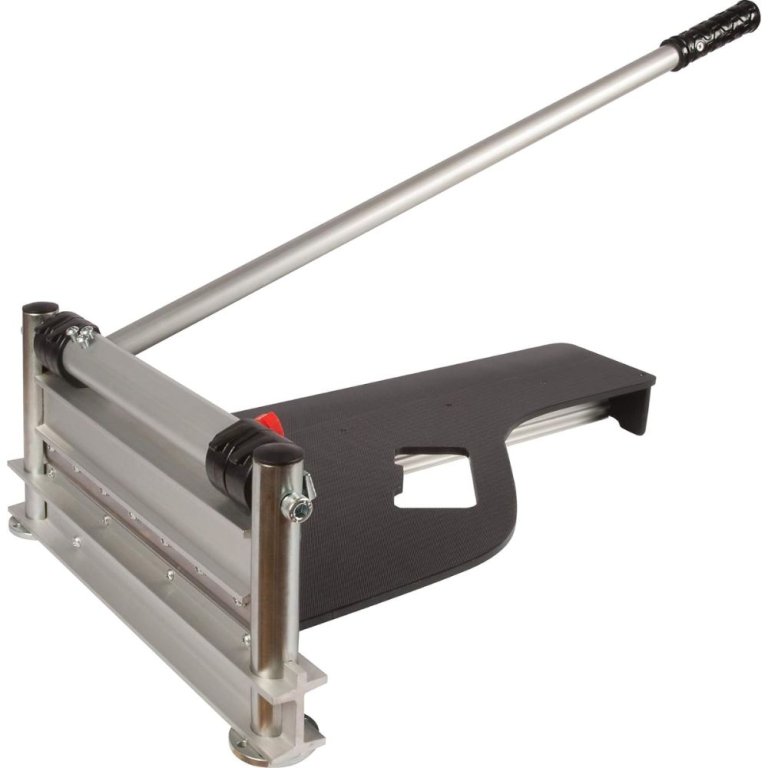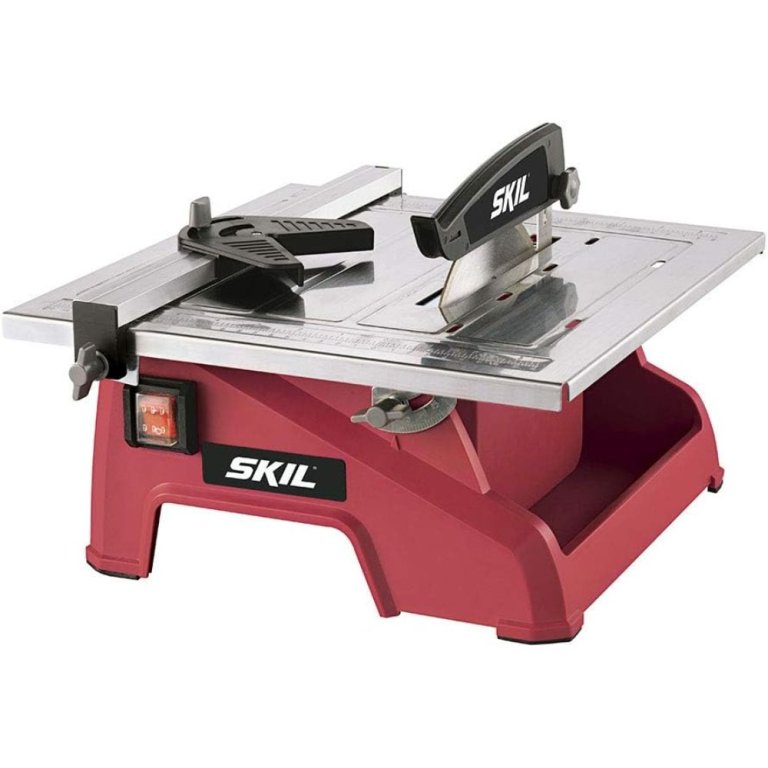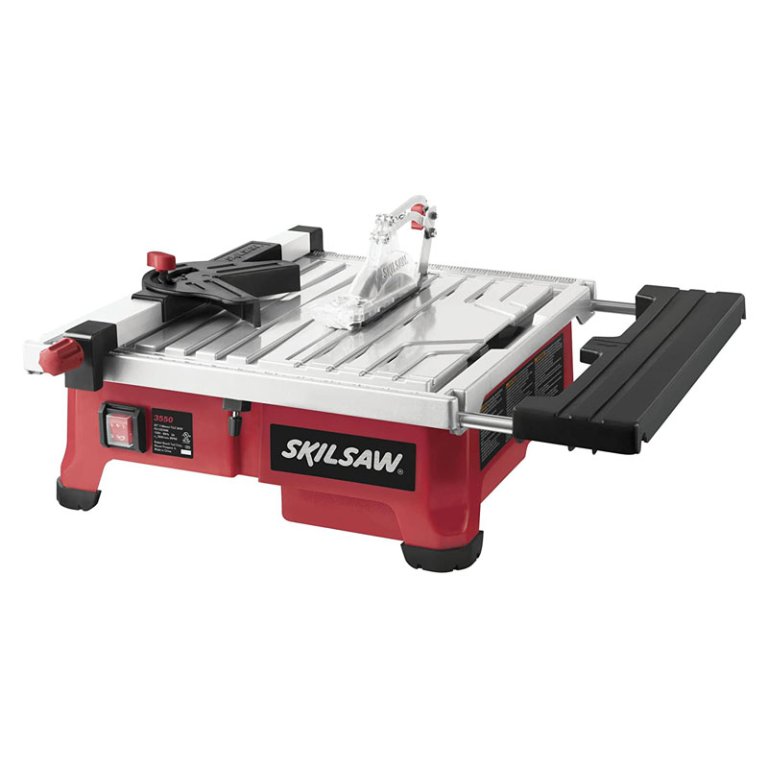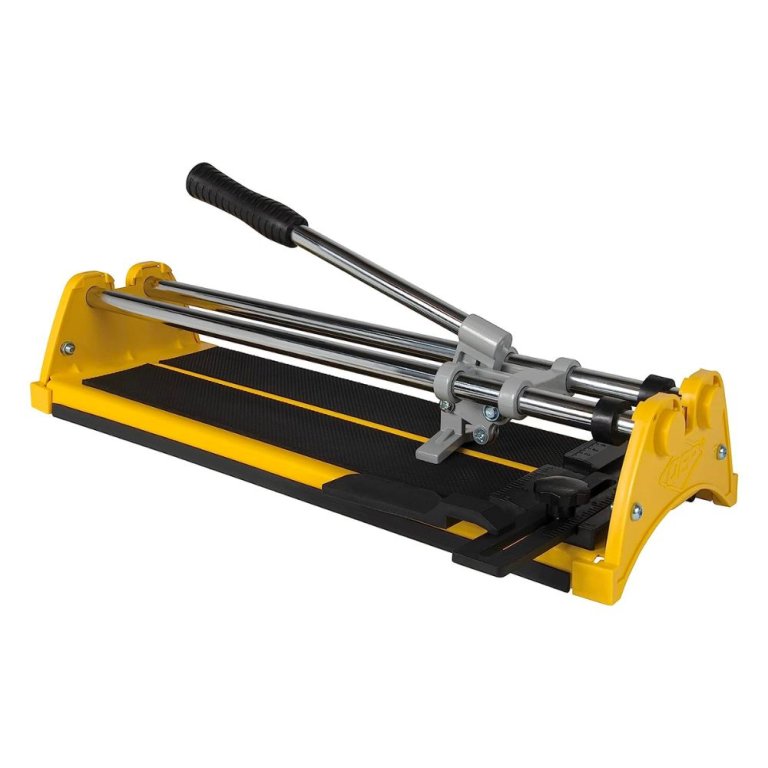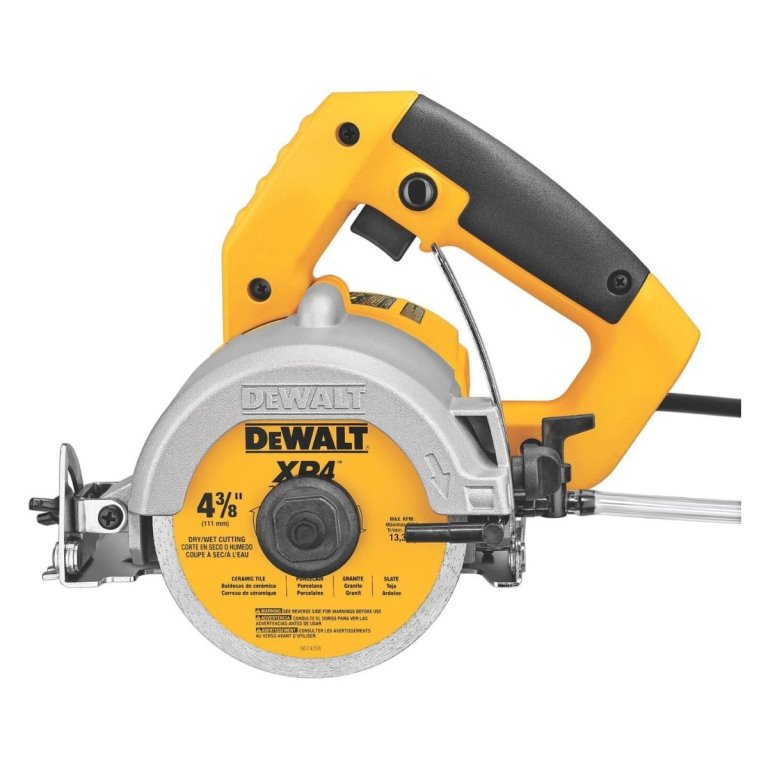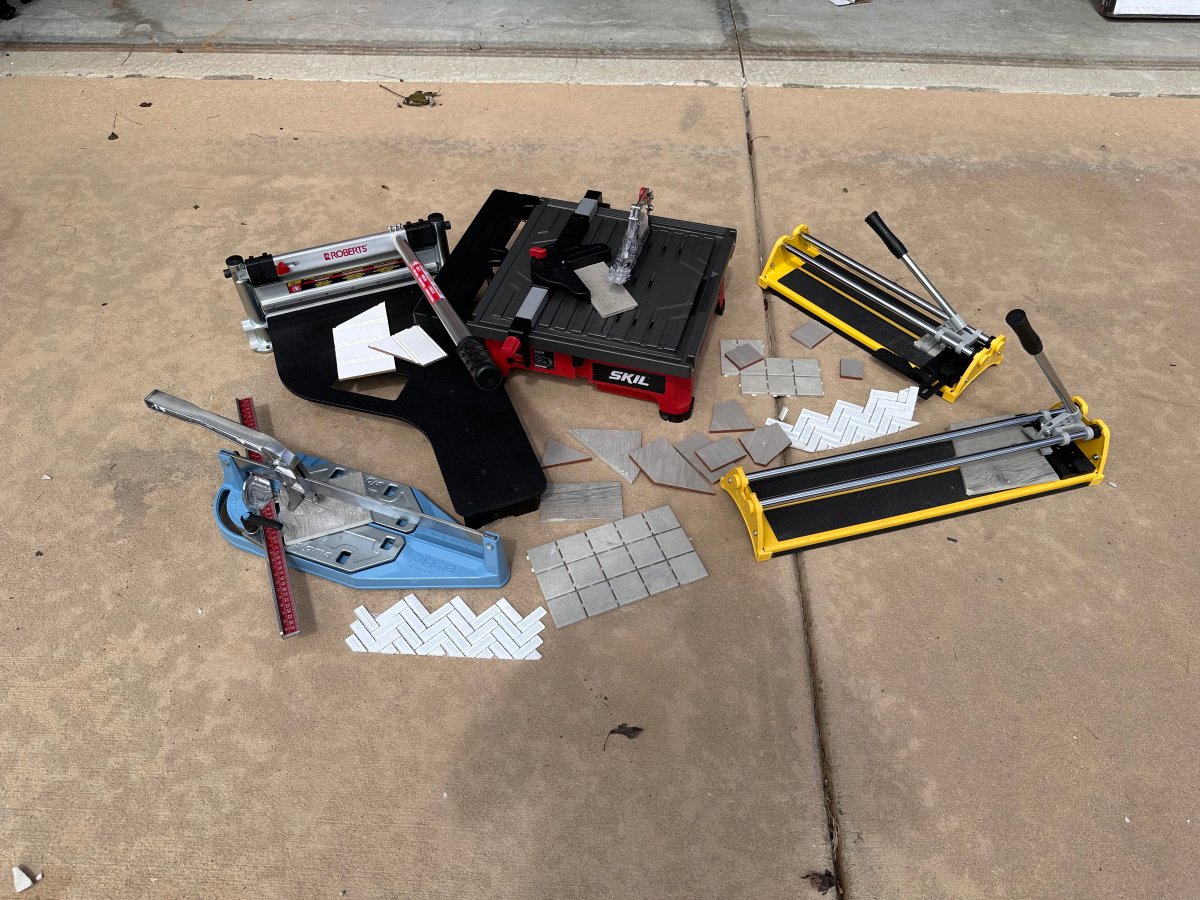
We may earn revenue from the products available on this page and participate in affiliate programs. Learn More ›
Installing new tile is one of those home projects that can make a significant impact relatively quickly, but you’ll need a good tile cutter and the right tools to get the job done. We put nine tile saws to the test, using them to cut various types of tiles to identify the best models.
There are a broad range of tile saws to choose from, including electric wet tiles saws for bigger jobs and manual tile saws for tiling projects that require fewer cuts. Tile saws also vary in their cutting capacity and ability to cut different types of materials. Our favorite is the Sigma 2G 37cm Pulling Incision Tile Cutter due to its lightweight design; it’s also able to cut through thick tile and make angled cuts.
Below is a list of our top picks for the best tile cutters on the market, chosen through extensive research, hands-on testing, and customer feedback. We kept several considerations in mind (detailed below) when selecting the best tile cutters for a given project.
- BEST OVERALL: Sigma 2G 37cm Pulling Incision Tile Cutter
↓ Jump to Review - RUNNER-UP: QEP 10630 24-Inch Manual Tile Cutter
↓ Jump to Review - BEST BANG FOR THE BUCK: QEP 10214Q 14-Inch Pro Tile Cutter
↓ Jump to Review - BEST PROFESSIONAL: DeWalt D24000S 10-Inch Wet Tile Saw With Stand
↓ Jump to Review - BEST FOR VINYL: Roberts 10-63 13-Inch Multi-Floor Cutter
↓ Jump to Review - BEST FOR BEGINNERS: Skil 3540-02 7-Inch Wet Tile Saw
↓ Jump to Review - BEST WET SAW: Skil 3550-02 7-Inch Wet Tile Saw
↓ Jump to Review - BEST FOR LARGE TILE: QEP 10220Q 20-Inch Pro Tile Cutter
↓ Jump to Review - BEST HANDHELD: DeWalt DWC860W 4⅜-Inch Wet/Dry Tile Cutter
↓ Jump to Review
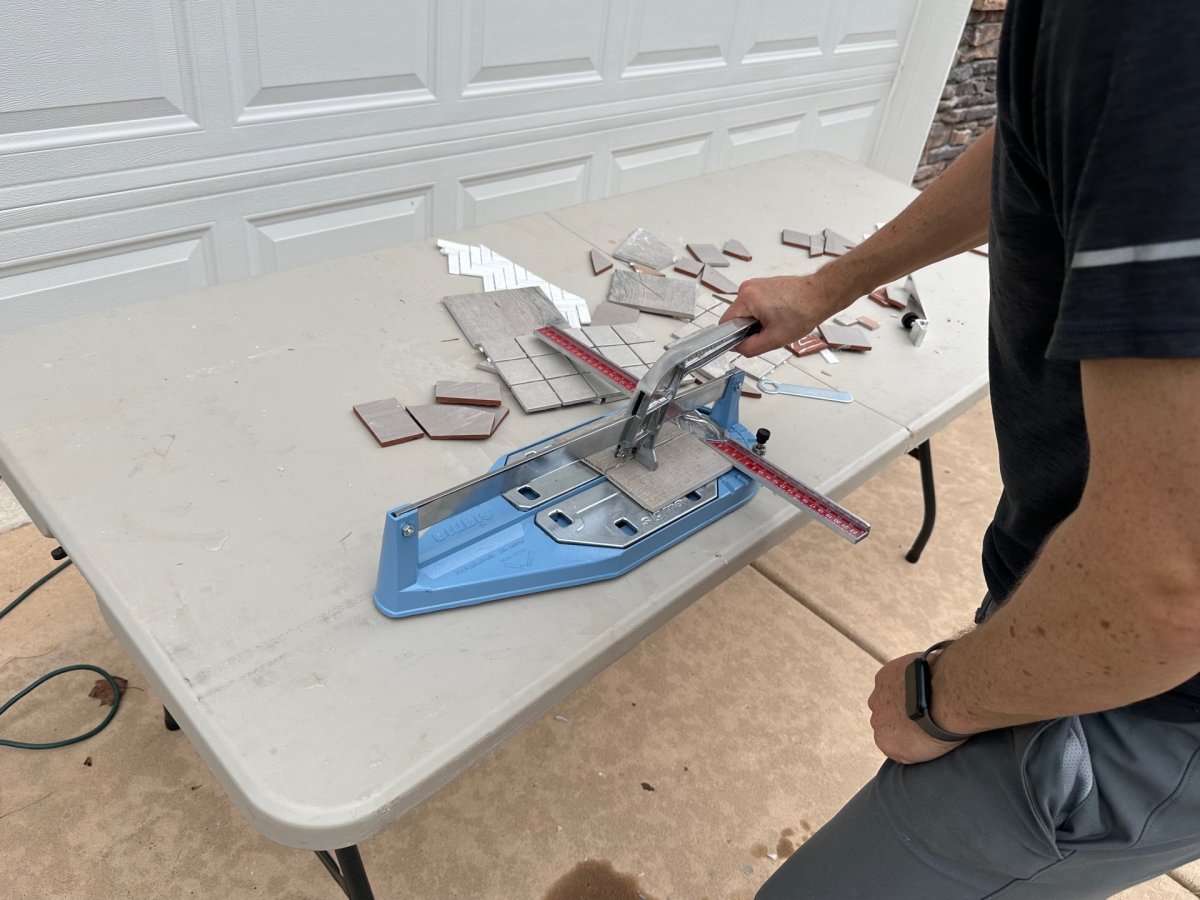
| Testing Stats | |
|---|---|
| Products tested | 9 |
| Time spent testing | 5 hours |
| Tests performed | 4 |
| Price range | $35 to $1,000 |
Our Top Picks
Below are some of some of the most popular reviewed and tested tile cutters on the market. We included a list of specs for each tile cutter, along with the things we liked and didn’t like about each one.
Best Overall
Sigma 2G 37cm Pulling Incision Tile Cutter
What We Like
- Miter fence makes it easy to set up angled cuts
- Can cut through thicker tile
- Lightweight design
What We Don’t Like
- Not for smaller backsplash tiles
- Pricey for a manual tile cutter
Product Specs
- Compatible tile materials: Porcelain, glass, ceramic, marble, and granite
- Type: Manual
- Pull vs. push: Pull
- Cutting size: 14.5 inches (rip cuts), 10.2 inches (diagonal cuts)
Our Ratings: Ease of Use 4.5/5; Accuracy 4/5; Cut Quality 4/5; Value 3/5
Looking for a manual tile cutter that can handle almost any tile? Check out the Sigma 2G 37-centimeter (cm) pulling incision tile cutter. This pull-type manual tile cutter can make straight lines and cuts on tiles up to 14.5 inches and diagonal cuts of up to 10.2 inches. It can also handle several tile thicknesses without any adjustments and has the capacity to cut tiles up to 0.5 inch thick.
The adjustable measuring guide of this less-than-5-pound tile cutter swivels up to 45 degrees in either direction with its rapid positioning button, allowing the user to make the angled cuts required for the job. It uses a tungsten-steel scoring wheel that can handle a variety of materials, including glass, porcelain, and ceramic, while also snapping stone that’s harder to cut, such as marble and granite.
We liked the ability to make angled cuts with this cutter. Unlike other cutters we tested, the Sigma is set up like a miter saw with a fence that rotates to several different preset angles (you can set it to custom angles, too). This makes setting up angled cuts far easier than with others we tested. The Sigma was capable of cutting and scoring the bathroom tile and also the thicker patio tile we tested. Although we did shatter a few at first by applying more pressure than what was needed, it provided reliable results once we got the hang of it. While it did perform angled cuts reliably, as with others we tested, the cuts tended to be uneven at the edges. That one gripe aside, it’s one of the best manual tile cutters you can buy.
Get the Sigma tile cutter at Amazon.
Runner-Up
QEP 10630 24-Inch Manual Tile Cutter
What We Like
- Suitable for ceramic and porcelain tiles
- Wide aluminum-alloy base offers stability
- ⅞-inch titanium-coated tungsten-carbide cutting wheel
- Straight-edge guide enables accurate tile alignment
What We Don’t Like
- Does not cut bevels
- Requires practice to achieve precise cuts
Product Specs
- Compatible tile materials: Most common tile types
- Type: Manual
- Pull vs. push: Push
- Cutting size: 24 inches (rip cuts), 16 inches (diagonal cuts)
Our Ratings: Ease of Use 4.2/5; Accuracy 4/5; Cut Quality 4.2/5; Value 4.3/5
This 24-inch tile saw is capable of cutting 24-inch straight cuts or 16-inch 45-degree cuts. Similar to other manual tile saws, it uses a score snap design to cut through tile up to 0.5- inch thick. QEP’s manual tile saws are known for their build quality, and this model is no exception with its dual chrome-plated steel rails and ball-bearing slides that make scoring tile an easier process.
During testing, the QEP 10630 excelled with ceramic and porcelain tiles, cutting through each type reliably. Its titanium-coated tungsten-carbide scoring wheel cut easily into the surface of our test tiles, although it wasn’t as effective cutting glass tiles, producing jagged sharp edges. We particularly liked its broad base, rubber feet, and table extensions, all of which served to make this tile cutter more stable when working with larger tiles. We also found the adjustable measurement guide to be a useful feature, especially when making repeated cuts of the same size.
Overall, this QEP tile saw is a great option if you’re looking for something that doesn’t lack cutting capacity and is more affordable and less messy than a wet saw.
Get the QEP 10630 tile cutter at The Home Depot or Amazon.
Best Bang For The Buck
QEP 10214Q 14-Inch Pro Tile Cutter
What We Like
- Makes reliable straight cuts across multiple tile types
- Easy-to-use design
- Can cut through small glass tiles reliably
What We Don’t Like
- Angled cuts usually come out uneven
Product Specs
- Compatible tile materials: Ceramic and porcelain
- Type: Manual
- Pull vs. push: Pull
- Cutting size: 14 inches (rip cuts), 10 inches (diagonal cuts)
Our Ratings: Ease of Use 4.5/5; Accuracy 4/5; Cut Quality 3.7/5; Value 4/5
QEP’s 14-inch tile cutter is an affordable tool that’s appropriate for a small flooring or backsplash tiling project. This manual pull-style tile cutter has a rip cut capacity of up to 14 inches and a diagonal cut capacity of up to 10 inches with a large handle that produces excellent cutting power. It can handle tiles up to 0.5 inch thick as well.
Coming in at a price that won’t break the bank, this QEP model still boasts plenty of nice-to-have features to get the job done. It provides heavy-duty rubber pads to keep it from slipping or marking the surface on which you’re working. The tile cutter also offers a rubber-padded handle for comfort and a padded snapping foot that snaps tile without scratching it.
The QEP 10214Q is a very capable tile cutter. With its 0.5-inch titanium-coated tungsten-carbide scoring wheel, we had no problem making cross cuts on larger ceramic tiles and smaller 1-inch tiles, and while cutting smaller glass backsplash mosaic tiles was certainly more awkward and challenging, it was doable. This little cutter capably cut through everything we threw at it without chipping or shattering; its only hiccup was with angled cuts. Although this QEP fared better than the larger model we tested, the cuts weren’t perfect and usually left behind uneven cut lines. However, this is a great budget-priced tile cutter for small- to medium-size tiles.
Get the QEP 10214Q tile cutter at Amazon or Ace Hardware.
Best Professional
DeWalt D24000S 10-Inch Wet Tile Saw With Stand
What We Like
- Includes height-adjustable saw stand
- Stand can be mounted to the floor
- Makes a variety of cuts, including rip, plunge, and diagonal
- Water flow on the blade eliminates airborne dust
- Includes ground-fault circuit interrupter (GFCI) switch, onboard storage, and submersible pump
What We Don’t Like
- Some assembly is required before use
- Included blade not as durable as other DeWalt options
- Limited portability
Product Specs
- Compatible tile materials: Porcelain, granite, ceramic, marble, and glass
- Type: Electric
- Pull vs. push: Push
- Cutting size: 25 inches (rip cuts), 28 inches (plunge cuts), 18 inches (diagonal cuts)
Our Ratings: Ease of Use 4.6/5; Accuracy 4.7/5; Cut Quality 4.7/5; Value 4.3/5
DeWalt’s wet tile saw certainly isn’t cheap, but if you find yourself taking on a lot of tiling projects each year or lay tile for a living, it’s a worthy investment. Quite simply, it’s one of the best and most feature-rich tile saws you can buy. It has a straight cutting capacity of up to 25 inches, can make plunge cuts up to 28 inches, and is capable of making a 45-degree miter cut of up to 18 inches.
Along with tile, you can also use it to take on pavers since it has a max depth cut of 3.125 inches. Plus, it tilts 45 degrees to execute bevel cuts. The saw also comes with its own foldable stand, so you don’t need to worry about finding a work surface to rest it on.
With its large 1.5 horsepower motor, the DeWalt wet saw blazed through testing, slicing through ceramic tiles and even harder travertine with ease. The stand provided a sturdy support with no swaying or wobbling during cuts. Our only gripe was with the included blade, which seemed to wear quickly when faced with tougher porcelain tiles. We’d recommend purchasing a different blade if you plan on using this tile saw with porcelain. Other than that, this is an impressive tile saw worthy of a pro worksite.
Read our full review: DeWalt D24000S 10-Inch Wet Tile Saw With Stand
Get the DeWalt D24000S tile saw at Amazon, The Home Depot, or MSC.
Best For Vinyl
Roberts 10-63 13-Inch Multi-Floor Cutter
What We Like
- Excellent build quality
- Slices through wood flooring up to 0.5 inch thick easily
- Sturdy base holds tool steady during cuts
What We Don’t Like
- Similar in price to some miter saws
Product Specs
- Compatible tile materials: Vinyl and engineered wood
- Type: Manual
- Pull vs. push: Push
- Cutting size: 13 inches (rip and diagonal cuts)
Our Ratings: Ease of Use 4.5/5; Accuracy 4/5; Cut Quality 5/5; Value 4/5
When tackling a vinyl tile project, consider a high-quality flooring cutter that can get the job done quickly and accurately. The Roberts 10-63 flooring cutter is a guillotine-style cutter that can handle materials such as vinyl tile, vinyl flooring, laminate flooring, and engineered wood flooring up to 13 inches wide and 0.5 inch thick. It can chop excess material off these materials in no time.
This manual cutter from Roberts features a long handle, which can apply plenty of leverage for quick cutting without straining. It also boasts a built-in angle gauge that’s helpful for making repeated cuts at a consistent angle.
We tested the Roberts multifloor cutter on thick vinyl plank flooring and had no trouble making a clean cut through the wood when applying moderate pressure. The large tray provided good support for the flooring pieces, holding them level and steady while we performed each cut. We also liked the large rubber feet, which kept the cutter in place when we applied pressure to the lever. The simple fence was also effective at creating miter cuts on our test flooring samples.
Our only complaint with the Roberts floor cutter is its price tag. For the same price, you can purchase a budget-priced miter saw, which can be used for a host of cutting projects. This particular tool is limited to flooring. That said, it’s a very well-made piece of equipment that performs well, doesn’t produce sawdust (key if you’re working in a living area), and would last through many flooring projects.
Get the Roberts tile cutter at Amazon, Ace Hardware, or The Home Depot.
Best For Beginners
Skil 3540-02 7-Inch Wet Tile Saw
What We Like
- Lightweight and portable at just 18 pounds
- Durable stainless steel construction for easy maintenance
- Ideal for consistent straight and diagonal cuts
What We Don’t Like
- Reservoir doesn’t catch all water
- Not suitable for cutting hard tile
- Does not have a GFCI switch
Product Specs
- Compatible tile materials: Ceramic, glass, stone/masonry
- Type: Electric
- Pull vs. push: Push
- Cutting size: 7.75 inches (rip cuts), 7.25 inches (diagonal cuts)
Our Ratings: Ease of Use 4/5; Accuracy 4/5; Cut Quality 4/5; Value 4.5/5
If you take on only the occasional tiling project, then it doesn’t make sense to spend hundreds of dollars on a top-of-the-line or even mid-priced tile saw. This budget-priced model from Skil will help you get the job done while keeping your project on budget.
The Skil 7-inch wet tile saw does the basics well. It can make up to 7.75-inch rip cuts, comes equipped with a miter gauge for making angled cuts, and has an adjustable fence. It also comes equipped with an adjustable work table that allows you to make bevel cuts of up to 45 degrees. We liked the stainless steel work top, which is something we didn’t see on other tile saws at this price point.
Although it won’t cut through tile as quickly as some of the more powerful saws we tested, it’s capable of cutting through porcelain, ceramic, and glass with precision. Also, while we liked the fact that the splash guard sat high enough that we could easily see the cutline, the saw had a tendency to throw a lot of water. Keeping a close eye on the reservoir level to make sure it didn’t run dry was crucial. With its low price, it’s a great saw for any DIYer taking on an occasional tiling project.
Get the Skil 3540-02 tile cutter at Amazon, Lowe’s, Walmart, or Menards.
Best Wet Saw
Skil 3550-02 7-Inch Wet Tile Saw
What We Like
- Makes clean cuts through tile
- Table and fence for making bevel and miter cuts
- Extension table for large tile
- Blade guard limits mess
What We Don’t Like
- It has a lot of plastic parts
Product Specs
- Compatible tile materials: Ceramic, glass, porcelain tiles
- Type: Electric
- Pull vs. push: Push
- Cutting size: 18 inches (rip and diagonal)
Our Ratings: Ease of Use 4.6/5; Accuracy 5/5; Cut Quality 4/5; Value 4.6/5
Skil’s 3,600-revolutions-per-minute (RPM) wet saw can handle tiles up to 18 inches wide on straight cuts. It boasts an adjustable tilting deck for making 22.5-degree and 45-degree bevels for miters. It also offers an adjustable fence that provides a consistent guide for straight and even cuts, plus an aluminum tabletop and sliding side extension for supporting larger tiles while cutting.
Given how affordable this wet saw is, we were impressed with its performance. It had no problem slicing through our thicker porcelain patio tiles, yet it was also capable of making precision cuts on small glass backsplash tile. Its beveling table is simple to use and made clean bevel cuts on bathroom tile.
Most wet saws are, well, wet, splashing water all over you and the surrounding area. While Skil’s saw does produce some spray, its well-designed Hydro Lock Water Containment System keeps it to a minimum by blocking most of the spray and sending it back into the basin below. The cover even has a small hole that allows you to view the cutline, which is essential when making precision cuts.
Despite the fact that this saw has a good amount of plastic parts, including the miter fence and extension table, its build quality is good. We think it’s a great value for any DIYer taking on a sizable tiling project.
Get the Skil 3550-02 tile cutter at Amazon.
Best For Large Tile
QEP 10220Q 20-Inch Pro Tile Cutter
What We Like
- Heavy and sturdy base for cutting tile
- Scores tile easily
- Makes precision straight cuts reliably
- Can handle up to 20-inch tile
What We Don’t Like
- Shatters tile when attempting angled cuts
Product Specs
- Compatible tile materials: Ceramic and porcelain
- Type: Manual
- Pull vs. push: Push
- Cutting size: 20 inches (rip cut), 14 inches (diagonal cuts)
Our Ratings: Ease of Use 4.5/5; Accuracy 4/5; Cut Quality 3.7/5; Value 3.5/5
For a manual tile cutter that will snap porcelain and ceramic tiles, give the 10220Q 20-inch tile cutter from QEP a look. This tile cutter can handle porcelain or ceramic floor tiles up to 20 inches long and has a 14-inch diagonal cut capacity on tiles up to 0.5 inch thick.
It comes with a variety of accessories designed to make cutting tiles manually easier. For example, two foam side pads and dual chrome-plated steel rails with bumpers hold the tile in place during scoring while also compressing a bit when the tile snaps.
The QEP 10220Q performed with mixed results during testing. We liked its large size and reinforced steel base, which created a sturdy surface for cutting our ceramic tile. Its 0.5-inch titanium-coated tungsten-carbide cutting wheel did a great job of scoring the tile surface with just moderate pressure; it made flawless straight cuts across the tile surface. The extra-long handle provided enough leverage that when we pulled with moderate pressure, it routinely broke each tile we cut right on the score line.
Angled cuts were a different story. We tried making an angled cut several times, only to shatter each tile into numerous pieces. While the QEP is a great tile cutter for making straight cuts across larger tiles, you’ll want to look elsewhere for a tool that can make angled cuts.
Get the QEP 10220Q tile cutter at Amazon or Ace Hardware.
Best Handheld
DeWalt DWC860W 4⅜-Inch Wet/Dry Tile Cutter
What We Like
- 4⅜-inch blade for wet or dry cuts
- Uses water for debris- and dust-free cutting
- Lightweight handheld tile cutter cuts any tile size
What We Don’t Like
- May not be as accurate as models with fences or guides
Product Specs
- Compatible tile materials: Glass, ceramic, brick, porcelain, and travertine
- Type: Electric
- Pull vs. push: Push
- Cutting size: Unlimited
Our Ratings: Ease of Use 4.7/5; Accuracy 4.6/5; Cut Quality 4.5/5; Value 4.5/5
While a manual tile saw or wet saw may be the best tool for cutting most tile, they won’t do for very large pieces of tile, a granite kitchen countertop, large brick pavers, or other materials that are simply too large to run through a tile saw. For those bigger projects, you’ll want this DeWalt 4⅜-inch handheld tile saw. The handheld wet saw, which can cut through a variety of masonry, has a hose that connects to a standard garden hose, feeding water to the blade to keep it cool as you cut.
This tool was a stone-cutting machine during testing. We used it to carve up a variety of materials, including ceramic, glass, porcelain, and travertine stone. We could even cut through brick pavers. The handle also bevels, which allowed us to execute bevel cuts of up to 45 degrees.
To test its abilities as a wet saw, we connected the DWC860W’s water hose to a garden hose. While it worked well to keep the blade cool, it produced so much water that we’d recommend using it outdoors or having a helper on hand with a wet/dry vac to keep the mess at a minimum. This new take on the wet saw is a great option if you’re planning on working with large pieces of masonry.
Get the DeWalt DWC860W tile cutter at Amazon, Lowe’s, The Home Depot, or MSC.
Jump to Our Top Picks
How We Chose and Tested the Best Tile Cutters
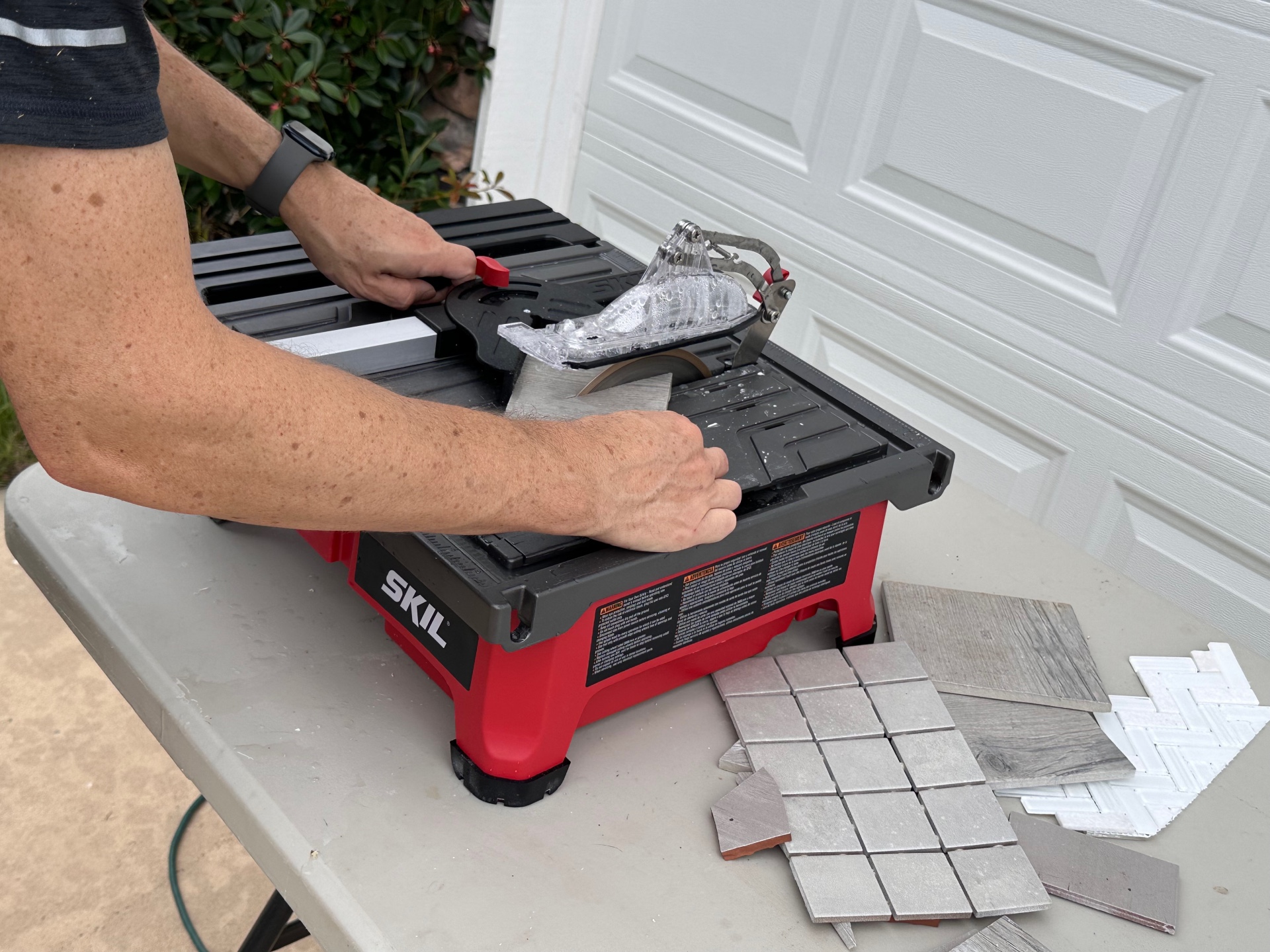
We researched and tested the most sought-after tile cutters in their respective categories and discovered that the best models are determined by their type, versatility, ease of use, and other special features included by top brands.
Each of our nine selections was put through its paces. We used each cutter to cut through a variety of materials, including porcelain and ceramic tile and, when appropriate, other materials, such as travertine and brick. We tested each saw’s ability to make straight cuts, miter cuts, and bevel cuts. Along with performance, we also considered build quality and price.
We also wanted to make sure that these tile cutters came with plenty of useful features like leverageable handles, diamond or tungsten scoring wheels or blades, water reservoirs and pumps for reduced heat and dust, adjustable stops, rubber padding, and even GFCI switches on the electric models for added safety.
What to Consider When Choosing a Tile Cutter
Reviewing and testing these cutters provided better insight into how a tile cutter works and which style is best for which project. However, before you start shopping, there are a few key items to understand about the best tile cutters. Below are the main considerations to keep in mind while choosing the right tile cutter for a particular retiling project in a bathroom, kitchen, laundry room, or sauna.
Tile Material
After you choose the tile for your retiling project, the second consideration is how to cut it. Which tile cutter or saw to use depends on the tile material:
- Pick a manual tile cutter for porcelain and ceramic tiles. These tiles score and snap easily, and cleanup is a breeze, making the installation process much more enjoyable.
- Cut materials like slate, marble, and other stone tiles on a wet tile saw to produce the desired results. These materials can be harder to snap cleanly, so a wet saw is an ideal option for the job.
- Score and snap vinyl tiles by hand, but using a vinyl tile cutter makes the job go faster and gives you a more precise result. These cutters work like tile guillotines, slicing through material quickly and accurately.
- Use a manual tile cutter for glass tiles, as they snap quite easily. Be aware, though, that there will be small shards of glass left behind. To avoid those sharp slivers, a wet saw will do the trick as well.
Manual vs. Electric
Picking the best tile cutter for a retiling project may come down to a choice between a manual cutter or an electric saw. Deciding on a viable option takes some consideration since, for example, porcelain, ceramic, and glass tiles can be cut with either an electric saw or a manual tile cutter.
- Manual tile cutters are fast, quiet, and relatively neat. They don’t use water or electricity. However, the snapped edges of the tiles will be rougher when using a manual tile cutter, and glass tiles can leave behind shards, so keep those points in mind.
- Electric cutters—also referred to as wet saws—have spinning blades that cut tile. They also use water to lubricate the blade, which can be a bit messy. (Some saws do a better job of containing the mess than others.) They can also be loud, but they make smoother cuts than manual tile cutters and can handle all tile material with just the push of a blade.
Push vs. Pull
Some manual tile cutters work by pushing the scoring wheel across the surface, while others require pulling the wheel instead. Choosing between the two options is largely a matter of preference.
- Push tile cutters are the most commonly available option. To cut the tile, simply lower the cutting wheel to the closest edge of the tile and push the handle across to the other side. Then, lower the snapping foot onto the surface at the far edge and push down until the tile snaps.
- Logically, pull tile cutters work the opposite way. Instead of pushing the wheel outward, pull it back. The change in leverage can make a pull tile cutter a bit less stable when lowering the snapping foot, but they work much the same way as a push tile cutter.
Power
It’s important to choose an electric-saw model that provides enough power for the job at hand. Plenty of inferior options are available, but they can do more frustrating than cutting. For a saw that will tackle most jobs, look for a model with at least 1 horsepower. These saws will work quickly and consistently, slicing through stone, glass, porcelain, and ceramic with ease.
To save on costs—or if a big, burly wet saw just won’t fit—there are other options. Just be sure to work slowly if the saw doesn’t have a ton of power. Jamming a tile into the blade of a less powerful wet saw can lead to chips and inconsistent cuts.
Cutter Size and Thickness
When working with larger tiles (more than 14 inches), be sure to size up to a tile cutter that can handle these bigger pieces. Even with smaller tiles, cutting them at a 45-degree angle requires more cutting capacity. Be sure to size the saw or cutter to the length of tile the project calls for.
Porcelain and ceramic floor tiles tend to be thicker than wall tiles, so they’re slightly more difficult to cut with a manual tile cutter. A wet saw will work much better on thicker tiles, as its diamond-grit blade and lubrication can easily cut through these tiles, though there will be a bit more mess and noise.
Extra Features and Accessories
When choosing the best tile cutter, keep an eye out for some extra features that will make the job that much easier. Many models feature legs that swing out from the cutter and provide extra stability for both the tile and the cutter. These legs can be particularly helpful when cutting wide tiles off-center.
To make the task at hand more manageable, it’s also worth purchasing a few extra accessories. A fine-point permanent marker or wax crayon can help make an easily visible cut line on a tile, especially on darker tiles on which pencil marks can disappear. A large speed square can also make marking tiles squarely much easier. Also, be sure to wear safety glasses, as both electric wet saws and manual tile cutters can send small particles flying.
FAQs
If you have remaining questions about cutting floor or wall tile with your new tile cutter, this next section may have the answer you’re looking for.
To cut a tile, lower the cutting wheel onto the surface of the tile. Push the wheel into the surface of the tile and roll it across the surface. At the other end, lift the handle so the snapping foot drops onto the tile surface. Press down until the tile snaps.
Porcelain and ceramic tiles are the easiest to cut. They’re fairly brittle, so scoring and snapping usually yield a clean result.
Porcelain tile has a consistent color on both the front and back of the tile. Ceramic tile typically has just a glazing, which means the front and back will potentially be different colors.
It might have a bent scoring wheel, or it could be the result of applying uneven pressure. If it’s an electric tile cutter, check if the blade is warped or slow down while pushing the material through.
The scoring wheel may be dull, or it may need more pressure. Change the blade and adjust the cutting technique to avoid breakage.
Whether electric tile cutters are better than manual, or vice versa, depends on your project. For large tile jobs that require a lot of cutting, an electric wet tile saw is your best bet. However, if your tiling job doesn’t require you to make a lot of cuts or if you’re working in a location where using a wet saw would be inconvenient, such as in a second-floor bathroom, a manual tile saw may make more sense.
Most professional tilers will use an electric wet tile saw to cut tiles. These machines cut through tile more quickly than manual saws, speeding up the job. They also do a better job of making miter cuts than a manual tile saw.
A wet tile saw is the best choice for a job that requires a lot of cuts. A dry-cut tile saw is the best choice when you’re working in a location where a wet tile saw (which can produce a lot of dust and mess) doesn’t make sense or when there isn’t easy access to water.
Meet the Testers
Tony Carrick is a freelance writer specializing in home improvement, landscaping, technology, home security, and design. He has conducted rigorous product testing on everything from power tools to home security systems to backyard grills. With each review, his goal is to help readers determine whether a product meets their needs and if it is or isn’t worth its price tag.
Glenda Taylor is a product tester and writer specializing in the construction, remodeling, and real estate industries. She tests a wide range of power tools as well as other home improvement, household, and lawn-and-garden products.
Additional research provided by Tom Scalisi.
